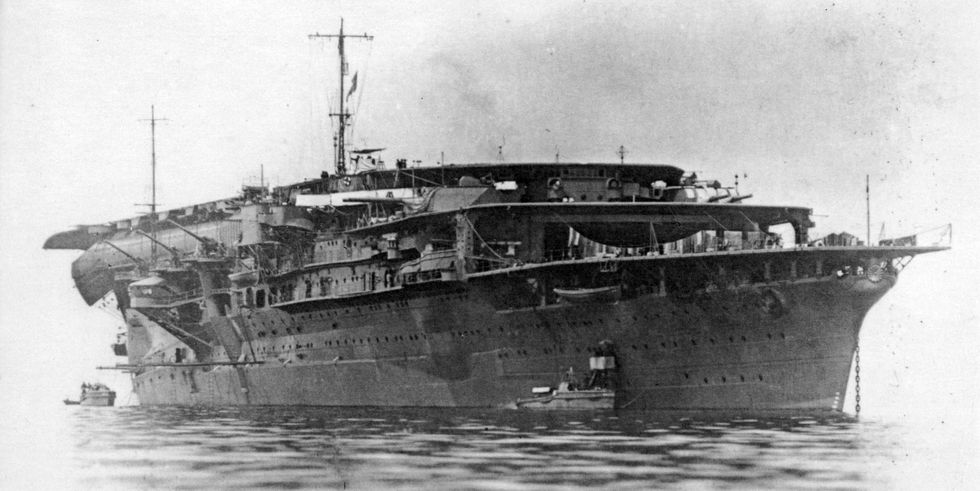Post by Admin on Nov 23, 2019 4:43:53 GMT
Explorers Find Sunken Japanese Aircraft Carrier from the Battle of Midway

Scientists, ocean explorers, and historians have found the Akagi, a Japanese aircraft carrier that sank during the Battle of Midway in World War II.
This is the second Japanese aircraft carrier that the team has found in a week, and earlier this year, the crew discovered the sunken USS Hornet near the Solomon Islands.
Intrepid scientists, ocean explorers, and historians aboard a research vessel have discovered a Japanese aircraft carrier that sank during the Battle of Midway in World War II.
Resting on her keel in nearly 18,000 feet of water roughly 1,300 miles northwest of Pearl Harbor in the Papahanaumokuakea Marine National Monument, the Akagi was unmistakable.
“I’m sure of what we’re seeing here, the dimensions that we’re able to derive from this image (are) conclusive,” Rob Kraft, the director of undersea operations for Vulcan Inc., which owns the research vessel, told the Associated Press. “It can be none other than Akagi.”
“I’m sure of what we’re seeing here, the dimensions that we’re able to derive from this image (are) conclusive,” Rob Kraft, the director of undersea operations for Vulcan Inc., which owns the research vessel, told the Associated Press. “It can be none other than Akagi.”
This is the second sunken ship the crew aboard the Petrel research vessel has found in the past week. Last Friday, the team spotted the Japanese aircraft carrier Kaga. While researchers previously found a piece of that ship’s wreckage in 1999, no one had located its hull until last week.
Many historians see the Battle of Mindway as a turning point in World War II. The U.S. intercepted communications about the Japanese fleet’s surprise attack on June 3, 1942, and waited for them to strike. The three-day, air-and-sea battle claimed the lives of 300 Americans and over 2,000 Japanese soldiers, as well as five Japanese ships and two American ships.
Before the Petrel team set out to find those ships, researchers had previously found just one back in 1998: the USS Yorktown. The experts aboard the Petrel hope their discoveries can shed light on the Battle of Midway's timeline of events.
Many historians see the Battle of Mindway as a turning point in World War II. The U.S. intercepted communications about the Japanese fleet’s surprise attack on June 3, 1942, and waited for them to strike. The three-day, air-and-sea battle claimed the lives of 300 Americans and over 2,000 Japanese soldiers, as well as five Japanese ships and two American ships.
Before the Petrel team set out to find those ships, researchers had previously found just one back in 1998: the USS Yorktown. The experts aboard the Petrel hope their discoveries can shed light on the Battle of Midway's timeline of events.
Early Sunday morning, the crew members spotted something on low-resolution scans, so they used their autonomous underwater vehicle (UAV) to get a better look. It returned beautiful high-frequency sonar imagery of the ship.
The 250-foot Petrel is working closely with the U.S. Navy to locate the ships. The experts' mission won’t be complete until they’re able to track down all of the missing ships. The Japanese aircraft carriers Soryu and Hiryu and cruiser Mikuma are still missing. Researchers haven't found the USS Hammann either.
The researchers won't publish the ships’ coordinates if and when they find them, and the locations of the U.S. Naval ships will be officially recognized as military gravesites. Earlier this year, the same team discovered the wreckage of the USS Hornet near the Solomon Islands.
“The terrible price of war in the Pacific was felt by all our navies,” Rear Adm. Brian P. Fort, commander of U.S. Naval Forces in Japan, told the Associated Press.
The 250-foot Petrel is working closely with the U.S. Navy to locate the ships. The experts' mission won’t be complete until they’re able to track down all of the missing ships. The Japanese aircraft carriers Soryu and Hiryu and cruiser Mikuma are still missing. Researchers haven't found the USS Hammann either.
The researchers won't publish the ships’ coordinates if and when they find them, and the locations of the U.S. Naval ships will be officially recognized as military gravesites. Earlier this year, the same team discovered the wreckage of the USS Hornet near the Solomon Islands.
“The terrible price of war in the Pacific was felt by all our navies,” Rear Adm. Brian P. Fort, commander of U.S. Naval Forces in Japan, told the Associated Press.











